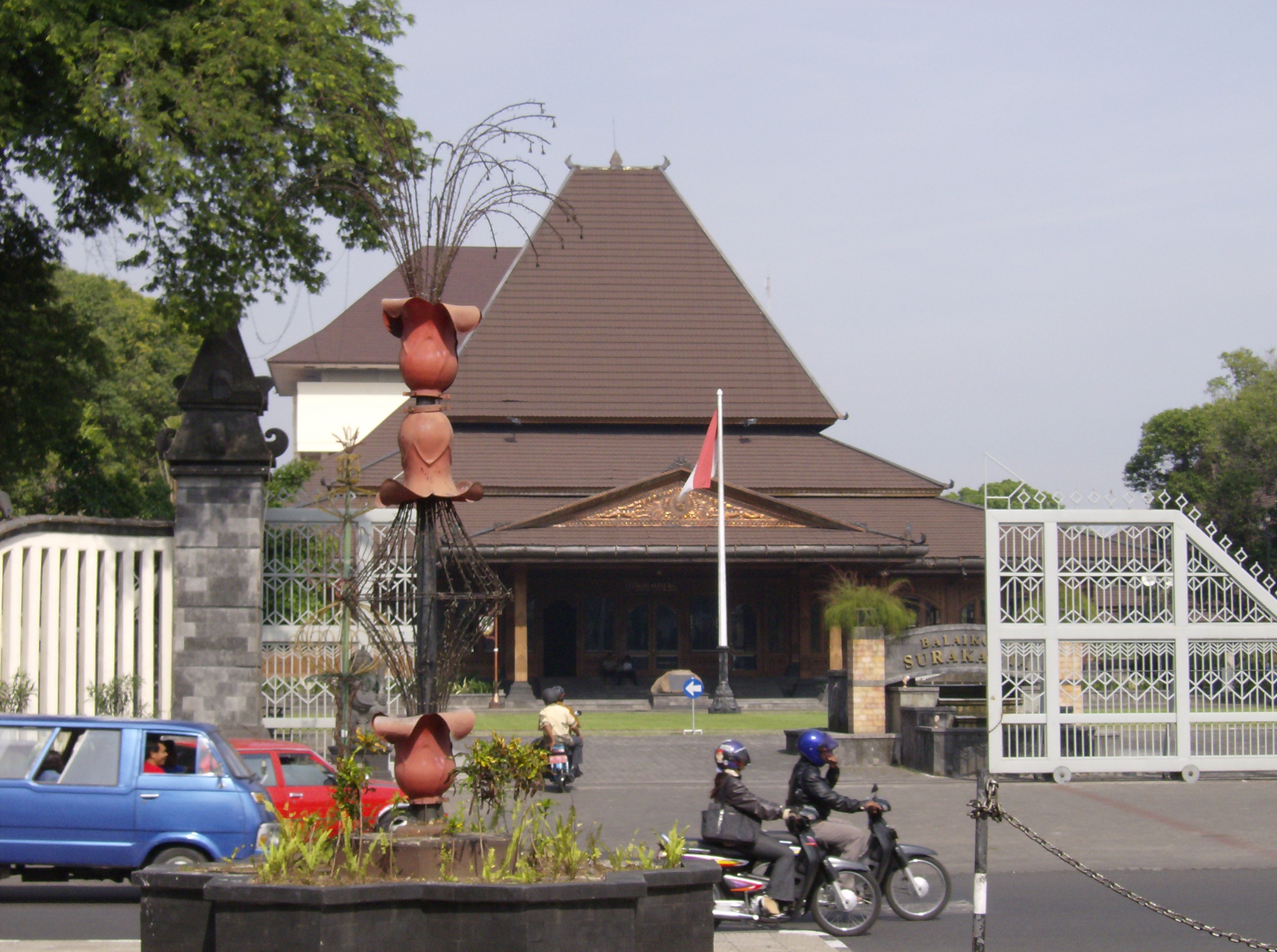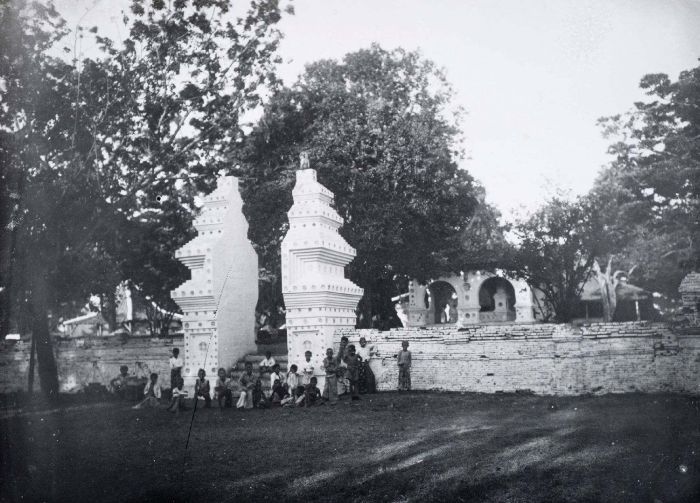|
Keraton
Kraton or keraton ( jv, ꦏꦿꦠꦺꦴꦤ꧀ or ꦏꦼꦫꦠꦺꦴꦤ꧀) is a type of royal palace in Java, Indonesia. Its name is derived from the Javanese ''ka-ratu-an'', meaning residence of the ''ratu'', the traditional honorific title for a monarch. In Java, the palace of a prince is called ''pura'' or ''dalem'', while the general word for palace is ''istana'', identical to Malay. Specific palaces Kraton that function as the residence of a royal family include: ;Yogyakarta (Jogja) region: *Kraton Ngayogyakarta Hadiningrat (Palace of Sultan Hamengkubuwono). * Pura Pakualaman (Palace of Adipati Pakualam). ;Surakarta (Solo) region: * Kraton Surakarta Hadiningrat (Palace of Susuhunan Pakubuwono). *Pura Mangkunegaran (Palace of Adipati Mangkunegara). ;Cirebon area: *Kraton Kasepuhan (Palace of Sultan Sepuh). *Kraton Kanoman (Palace of Sultan Anom). *Kraton Kacirebonan (Palace of Sultan Cirebon). *Kraton Kaprabonan ( id) (Palace of Sultan Prabon). Historical palaces The l ... [...More Info...] [...Related Items...] OR: [Wikipedia] [Google] [Baidu] |
Kraton Kacirebonan
The Kraton Kacirebonan is the oldest Kraton (sultan's palace) in the Indonesian city of Cirebon. It has existed since 1807. This colonial building has housed many historical relics such as Keris, Wayang puppets, war equipment, Gamelan instruments and others. Kacirebonan in the area of the District Pulasaren Pekalipan village, exactly 1 kilometer southwest of Kasepuhan Palace and approximately 500 meters south of Keraton Kanoman. Kraton Kacirebonan is positioned from north to south (as are the other palaces in Cirebon) with a land area of about 46,500 square meters. History History begins when Prince Sultan Kacirebonan King Kanoman, heir to the throne of the Sultanate Kanoman joined the people of Cirebon in rejecting taxes applied by Holland. Application of these taxes led to the revolt of the people in some places. As a result, Prince Raja Kanoman was captured by the Dutch and thrown into the fortress Viktoria in Ambon, stripped of his title, as well as deprived as Sultan Kanom ... [...More Info...] [...Related Items...] OR: [Wikipedia] [Google] [Baidu] |
Cirebon
Cirebon (, formerly rendered Cheribon or Chirebon in English) is a port city on the northern coast of the Indonesian island of Java. It is the only coastal city of West Java, located about 40 km west of the provincial border with Central Java, approximately east of Jakarta, at . It had a population of 296,389 at the 2010 census and 333,303 at the 2020 census. The built-up area of Cirebon reaches out from the city and into the surrounding regency of the same name; the official metropolitan area encompasses this regency as well as the city, and covers an area of , with a 2010 census population of 2,363,585; the 2020 census total was 2,603,924. Straddling the border between West and Central Java, Cirebon's history has been influenced by both Sundanese and Javanese culture as well as Arab and Chinese, and is the seat of a former Sultanate. Etymology Being on the border of Sundanese (i.e., Western Java) and Javanese (i.e., Central Java) cultural regions, many of Cirebon's ... [...More Info...] [...Related Items...] OR: [Wikipedia] [Google] [Baidu] |
Surakarta
Surakarta ( jv, ꦯꦸꦫꦏꦂꦠ), known colloquially as Solo ( jv, ꦱꦭ; ), is a city in Central Java, Indonesia. The 44 km2 (16.2 sq mi) city adjoins Karanganyar Regency and Boyolali Regency to the north, Karanganyar Regency and Sukoharjo Regency to the east and west, and Sukoharjo Regency to the south. On the eastern side of Solo lies Solo River (Bengawan Solo). Its built-up area, consisting of Surakarta City and 59 districts spread over seven regencies ("Greater Solo Area", formerly Special Region of Surakarta), was home to 3,649,254 inhabitants as of 2010 census, around half million of which reside in the city proper. Surakarta is the birthplace of the current President of Indonesia, Joko Widodo. He served as Mayor of Surakarta from 2005 to 2012. History Hominid habitation in the region of Surakarta is evidenced from roughly one million years ago, the age of the "Java Man" skeleton found 80 kilometers upstream. Another famous early hominid from this area is called ... [...More Info...] [...Related Items...] OR: [Wikipedia] [Google] [Baidu] |
Kraton Ngayogyakarta Hadiningrat
The Royal Palace of Yogyakarta ( id, Keraton Ngayogyakarta Hadiningrat, jv, ꦏꦿꦠꦺꦴꦤ꧀ꦔꦪꦺꦴꦒꦾꦏꦂꦠꦲꦢꦶꦤꦶꦔꦿꦠ꧀) is a palace complex in the city of Yogyakarta, Yogyakarta Special Region, Indonesia. It is the seat of the reigning Sultan of Yogyakarta and his family. The complex is a center of Javanese culture, and contains a museum displaying royal artifacts. It is guarded by the Yogyakarta Kraton Guards ( Indonesian: ''Prajurit Keraton Ngayogyakarta Hadiningrat''). History The complex was built in 1755–1756 ( AJ 1682) for Hamengkubuwono I, the first Sultan of Yogyakarta.OBYEK PENELITIAN http://elib.unikom.ac.id/ It was one of the monarch's first acts after the signing of the |
Kraton Kasepuhan
The Kraton Kasepuhan is the oldest kraton (sultan's palace) in the Indonesian city of Cirebon. It is the residence of the Sultan of Kasepuhan and the royal palace of Sultanate of Cirebon. History It was built in 1447 and its architecture and interior are a blend of Sundanese, Javanese, Islamic, Chinese and Dutch styles. While the sultan still lives in the palace, several main sections are open to the public. Inside is a pavilion with white-washed walls dotted with blue-and-white Delft tiles, a marble floor and ceiling hung with French chandeliers. The legacy of Majapahit is preserved in its small ''pendopo'' on soft carved brick bases. The carvings on the ''pendopo'' columns are 1940s copies of the ancient originals. An innovation is the use of brackets branching out from the columns. The main building features unusually tall pyramidal column bases. The ornament on the double braces of this building's ''pendopo'' '' tumpang sari'' ceiling are picked out in gilt. Another un ... [...More Info...] [...Related Items...] OR: [Wikipedia] [Google] [Baidu] |
Majapahit
Majapahit ( jv, ꦩꦗꦥꦲꦶꦠ꧀; ), also known as Wilwatikta ( jv, ꦮꦶꦭ꧀ꦮꦠꦶꦏ꧀ꦠ; ), was a Javanese people, Javanese Hinduism, Hindu-Buddhism, Buddhist thalassocracy, thalassocratic empire in Southeast Asia that was based on the island of Java (in modern-day Indonesia). It existed from 1293 to circa 1527 and reached its peak of glory during the era of Hayam Wuruk, whose reign from 1350 to 1389 was marked by conquests that extended throughout Southeast Asia. His achievement is also credited to his prime minister, Gajah Mada. According to the () written in 1365, Majapahit was an empire of 98 tributaries, stretching from Sumatra to New Guinea; consisting of present-day Indonesia, Singapore, Malaysia, Brunei, southern Thailand, Timor Leste, southwestern Philippines (in particular the Sulu Archipelago) although the scope of Majapahit sphere of influence is still the subject of debate among historians. The nature of Majapahit relations and influences upon its ... [...More Info...] [...Related Items...] OR: [Wikipedia] [Google] [Baidu] |
Trowulan
Trowulan is an archaeological site in Trowulan (subdistrict), Trowulan Subdistrict, Mojokerto Regency, in the Indonesian province of East Java. It includes approximately 100 square kilometres and has been theorized to be the site of the eponymous capital city of the Majapahit, Majapahit Empire, which is described by Mpu Prapanca in the 14th-century poem Nagarakretagama and in a 15th-century Chinese source. When it was the capital of the Majapahit Empire, the city was known as Wilwatikta, which is a name also synonymous with the empire's name. It was razed during the invasion of Girindrawardhana to defeat Kertabhumi in 1478. After this event Majapahit's capital was moved to Daha (Kediri (city), Kediri). The Trowulan Museum includes a collection of artifacts. The Nagarakretagama contains poetic descriptions of the palace of Majapahit and its surroundings but is limited to the royal and religious sectors. Some of the details are vague, and scholars who have tried to compile a plan ... [...More Info...] [...Related Items...] OR: [Wikipedia] [Google] [Baidu] |
Ratu Boko
Ratu Boko ( jv, Ratu Baka) or Ratu Boko Palace is an archaeological site in Java. Ratu Boko is located on a plateau, about three kilometres south of Prambanan temple complex in Yogyakarta, Indonesia. The original name of this site is still unclear, however the local inhabitants named this site after King Boko, the legendary king mentioned in Roro Jonggrang folklore. In Javanese language, Javanese, ''Ratu Boko'' means "Stork King". The site covers 16 hectares in two hamlets (''Dawung'' and ''Sambireja'') of the village of Bokoharjo and Prambanan, Sleman Regency. In striking contrast to other Classic-period sites in Central Java and Yogyakarta, which are remains of temples, Ratu Boko displays attributes of an occupation or Human settlement, settlement site, although its precise function is unknown. Probably the site was a palace complex which belonged to the kings of Sailendra or Mataram Kingdom that also built temples scattered across the Prambanan Plain. The argument was based on ... [...More Info...] [...Related Items...] OR: [Wikipedia] [Google] [Baidu] |
Surakarta Sunanate
Surakarta Sunanate ( id, Kasunanan Surakarta; jv, ꦟꦒꦫꦶꦑꦱꦸꦤꦤ꧀ꦤꦤ꧀ꦯꦸꦫꦏꦂꦠꦲꦢꦶꦤꦶꦁꦫꦠ꧀, ''Kasunanan/Karaton Surakarta Hadiningrat''; nl, Soerakarta) was a Javanese monarchy centred in the city of Surakarta, in the province of Central Java, Indonesia. The Surakarta Kraton was established in 1745 by Pakubuwono II. Surakarta Sunanate and Yogyakarta Sultanate are together the successors of Mataram Sultanate. Unlike their counterparts in Yogyakarta, who use the title of sultan, the rulers of Surakarta use the title of sunan. The Dutch name was used during Dutch colonial rule until the 1940s. The title is sometimes anglicized as the , from the location of their palace. History After Sultan Agung I, the power and prestige of Sultanate of Mataram was declining due to a power struggle and conflict of succession within the royal family. The VOC (Dutch East India Company) exploited the power struggle to increase its control on Java, an ... [...More Info...] [...Related Items...] OR: [Wikipedia] [Google] [Baidu] |
Palace
A palace is a grand residence, especially a royal residence, or the home of a head of state or some other high-ranking dignitary, such as a bishop or archbishop. The word is derived from the Latin name palātium, for Palatine Hill in Rome which housed the Roman Empire, Imperial residences. Most European languages have a version of the term (''palais'', ''palazzo'', ''palacio'', etc.), and many use it for a wider range of buildings than English. In many parts of Europe, the equivalent term is also applied to large private houses in cities, especially of the aristocracy; often the term for a large country house is different. Many historic palaces are now put to other uses such as parliaments, museums, hotels, or office buildings. The word is also sometimes used to describe a lavishly ornate building used for public entertainment or exhibitions such as a movie palace. A palace is distinguished from a castle while the latter clearly is fortified or has the style of a fortification ... [...More Info...] [...Related Items...] OR: [Wikipedia] [Google] [Baidu] |
Kraton Kanoman
Kraton Kanoman is a palace in the Indonesian city of Cirebon in West Java. It was founded by Sultan Anom I in 1677. In the outer area of the palace, the ''siti inggil'', are masonry versions of the classic Javanese ''pendopo'' form, as opposed to the more conventional timber structures. Like the Great Mosque in Demak, Chinese ceramics are embedded into the plastered walls. The squat split-gates with pyramidal peaks are a Cirebon emblem. See also * Indonesian architecture * Sultanate of Cirebon * List of monarchs of Java * List of palaces in Indonesia This is list of palaces in Indonesia. Seven out of them are presidential palace. References {{Reflist * Palaces Palaces Indonesia Indonesia, officially the Republic of Indonesia, is a country in Southeast Asia and Oceania between t ... References * Schoppert, P., Damais, S., ''Java Style'', 1997, Didier Millet, Paris, pp. 46–47, Buildings and structures in Cirebon Palaces in Java Tourist attractions i ... [...More Info...] [...Related Items...] OR: [Wikipedia] [Google] [Baidu] |




.jpg)




